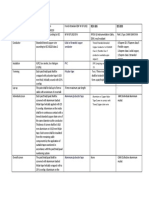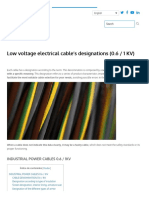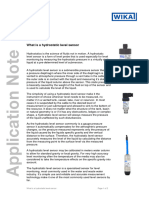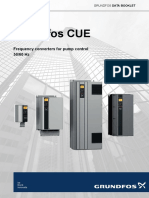Instrumentation Cables
Instrumentation Cables
Uploaded by
A GlaumCopyright:
Available Formats
Instrumentation Cables
Instrumentation Cables
Uploaded by
A GlaumOriginal Title
Copyright
Available Formats
Share this document
Did you find this document useful?
Is this content inappropriate?
Copyright:
Available Formats
Instrumentation Cables
Instrumentation Cables
Uploaded by
A GlaumCopyright:
Available Formats
Cheat Sheet:
Instrumentation Cables
INTRODUCTION
Instrumentation and Control cables are designed to carry signals from instrumentation and control equipment.
The cables comply with one of the following standards:
- BS5308 / PAS5308 Part 1 or 2 - British standard
- EN 50288-7 - European standard
- NF M87-202 - French standard
BS 5308 AND PAS 5308
British Standard BS 5308 has actually been withdrawn and superseded by the European standard EN 50288-7 but is still
commonly specified, and is often supplied under the Publicly Available Standard (PAS) equivalent.
The standard is split into two parts and then at least 2 Types (there is also a Type 3 with a Lead Sheath);
Part 1 covers Polyethylene and Cross-linked Polyethylene insulated cables
Part 2 covers PVC insulated cables
Type 1 covers cables both screened and unscreened
Type 2 covers cables that include a Steel Wire Armour (SWA)
Why do people still use PAS5308? The European standard BS EN 50288-7 doesn't necessarily adequately cover certain
constructions, higher voltage ranges, and dimensions. It should be noted that a PAS does not hold the same weight as a BS though.
The cables are suitable for operation at 300/500V and have Class 2 stranded or Class 5 flexible stranded Copper conductors. They're
not designed for direct connection to a low impedance source, such as the public electricity supply.
Identification colour coding
Constructions of up to 50 Pairs are either colour-coded as per the table from Annex C of the standard (on page 4 of this document) or
black/white or black/blue and numbered. Triples are not included in the BS5308 standard so colour coding is not defined (although is
often black/white/red numbered).
EN 50288-7
This European Standard was first published in 2005 and superseded BS5308 and other national types to harmonise instrumentation
cable standards. The Scope is defined as: ‘... multi-element cables suitable for connecting instruments and control systems for analogue
or digital signal transmission. They may or may not be screened and optionally may incorporate armouring and/or moisture or
environmental protection layers.’. The standard specifies the requirements for the various elements that make up the cables but does not
prescribe particular construction types. Cables covered by this standard have maximum rated voltages of 90V, 300V and 500V a.c.
Naming Convention
EN 50288-7 cables are often referred to by the following coding:
RE: Designation for instrumentation cables PSCR: Pairs screened M: Lead sheath
Ym: PVC high temperature OSCR: Over all screened Mz: Lead alloy sheath
Yo: PVC sheath with improved oil resistance PIMF: Pairs in metal foil (L)2Y: Multilayer sheath
2Y: Polyethylene (PE) TIMF: Triples in metal foil (L)2Y4Y: ALNYC sheath
2X: Cross linked polyethylene (XLPE) C: Copper wire braid (fl): Increased fire resistance
T or MGT: Mica glass tape Q: Steel wire braid CI: Circuit integrity
H: Low smoke zero halogen SWA: Steel wire armour
2G: Silicone rubber B: Flat steel tape armour
St: Overall screen FG: Flat steel wire helix
For example: RE-2X(st)Y SWAY PiMF are instrumentation cables with XLPE insulation, Overall screen, PVC inner sheath, SWA
armour, PVC outer sheath. The pairs are also individually screened in metal foil (underneath the overall screen).
Cheat Sheet - Instrumentation Cable www.elandcables.com 1
Cheat Sheet:
Instrumentation Cables
Identification colour coding
Unless otherwise specified (e.g. by means of numbered cores or tapes), the coding for identification shall correspond with the standard
colours shown in HD 402 S2. Coloured or numbered non-hygroscopic binder tapes may be applied over screened cabling elements as
identification.
NF M 87-202 PETROLEUM INDUSTRY, INSTRUMENTATION CABLES
French National Standard cable for armoured or unarmoured instrumentation cables in pairs, three core, four core, multiple pairs and
multiple three core (multiple pairs are used for multiple four core cables). Coloured or numbered non-hygroscopic binder tapes may be
applied over screened cabling elements as identification. These cables are used in extra-low voltage applications in petroleum and
petrochemical units for the transmission of a.c and d.c analogue signals.
Construction
Class 1 solid or Class 2 stranded Copper conductors (unlike EN 50288-7 which offers Class 5 flexible stranded as well), with PVC
insultion, although other materials such as XLPE or Silicone Rubber may be agreed. The major difference is in the armouring, which uses
a dual layer of steel tape (STA) as opposed to SWA, a waxed crepe paper separator, and the use of a PVC sheathing that is of a type
resistant to the aromatic hydrocarbons found in the petrochemical industry.
Cable type coding system for cables to NF M87-202 uses a 10 character alpha numeric system. The characters are in
pairs or series of two, see table below:
CODE MEANING OF CODE
1st series - Numbers of pairs, three cores, four cores
Pairs: 01, 03, 07, 12, 19 and 27
Two figures Three cores: 01, 07, and 12
Four core: 01
2nd Series - Type/Use
Paired series copper IP
Two letters Three core series: copper IT
Four core series: copper IQ
3rd series - composition of conductors
Two figures Single core pair, three core, four core: (7x 0.40 - cross sectional area 0.88mm2) 09
Multiple pairs and three cores: (1 x 0.8mm-cross sectional area 0.5mm2) 05
4th series - screen (Screening)
General screen EG
Two letters Indervidual screen and general screen EI
Indervidual screen per half cable + general screen EP
5th series - Mechanical protection
No strip - limited mechanical protection, delivery at stage of PVC sheathing which is resistant to aliphatic
hydrocarbons, = SF
Two letters Steel Strip - mechanical protection and PVC sheath for resistance with lead and PVC sheathing for
resistance to aromatic hydrocarbons = PF
Special sheath and steel strip for mechanical and chemical resistnance to Aromatic hydrocarbons without lead, = TF
(1) If multiple pairs or multiple three cores cables are connected to equipment subject to heavy vibration, more flexible cables should be used.
Coding system
A star to be used where cross linked polyethylene is used instead of PVC by agreement with Purchaser.
Identification colour coding
Single pair cable: Natural, Red ( or Blue or Yellow)
Single three core cable: Natural, Red, Blue
Single quad core cable: Natural, Red, Blue, Yellow
Multipair and multi three core cables;
The individual pairs: Natural, Red
The individual three core cables are: Natural, Red, Blue
Cheat Sheet - Instrumentation Cables www.elandcables.com 2
Cheat Sheet:
Instrumentation Cables
Identification between pairs and three core cables shall be obtained by numbering with the numbers printed in
accordance with NF C 30-201 either:
- On the natural member or
- On the PVC sheath of each pair or each three core cable
Some common materials used in instrumentation cables (and why)
PVC: Polyvinylchloride is used as either an insulation material or as a sheathing material. PVC is a highly versatile material which
has traditionally been used extensively across the cable industry. It is flame retardant and self-extinguishing. It can be modified for a
variety of applications including indoor and outdoor use, in wet and dry conditions, in conduit or direct burial and for both high and low
temperature application. PVC also has resistance to a wide range of chemicals including some oils and solvents. PVC is replaced in
certain applications by low smoke, halogen free materials, where there is a substantial risk to life and equipment in a fire situation.
PE: Polyethylene is used as either an insulation or sheathing material. It has excellent chemical resistance, including oils and extremely
low water absorption. It also has superior mechanical strengths and good low temperature resistance. PE cables tend to be somewhat
more rigid due to the hardness of the PE material and are not flame retardant. Due to the flammability the PE sheathing is generally used
with cables for outdoor applications or for direct burial.
XLPE: Cross-linking PE improves the performance of the cable, increasing the temperature and chemical resistance. This material is
used mainly as an insulation material.
LSZH: Low smoke zero halogen materials are used in place of PVC materials where there is a significant risk to life and equipment
in fire situations. These cables do not produce halogen acid gases when they burn and do not release the significant levels of dense
black smoke that the PVC equivalent materials would in the event of a fire. Various additives can be added to these materials to improve
resistance to chemicals including oils and solvents.
Silicone rubber is used in applications where there is a need for extended temperature ranges, suitable for applications from -90°C to
180°C. Silicone rubber is also used widely where cables are required to maintain circuit integrity under fire conditions.
Mica Tape: Glass backed mica tape is extensively used in fire resistant cables due to its exceptional performance as an insulation
material in a fire situation.
SWA: Steel wire armouring is used to offer a significant degree of resistance to mechanical impact. It is composed of either round steel
galvanised wires or flat steel galvanised wires helically wound around the bedding covering the insulated conductors.
Single or double layer of metal tape. Metal tape of either steel of brass is longitudinally wrapped around the bedding covering the
insulated cores. This cable whilst offering a tough tight covering seal over the cores is also somewhat less flexible than the SWA version.
Tapes offer the most complete covering. The steel tapes provide the best inductive protection whereas the brass tapes are most
frequently used as rodent protection.
Metal Braid: The braid is either galvanised steel or plain or tinned copper wires. Braiding these fine wires makes the cable more flexible
and lightweight than the other means of mechanical protection, SWA and metal tapes.
Lead or Lead alloy sheath: Lead sheathing offers the best protection against oils and chemicals and essential where there is constant
exposure in heavily polluted mud with hydrocarbon content. Lead alloy is a lighter alternative to the chemical barrier offered by lead, it is
frequently used in areas of high vibration
Cheat Sheet - Instrumentation Cables www.elandcables.com 3
Cheat Sheet:
Instrumentation Cables
Annex C - BS5308 / PAS5308
Table C.1 Identification of cable pairs other than two-pair cables without individual pair screens (quads)
NO. OF PAIRS A-WIRE B-WIRE NO. OF PAIRS A-WIRE B-WIRE
1 Black Blue 26 White Yellow
2 Black Green 27 Red Yellow
3 Blue Green 28 Orange Yellow
4 Black Brown 29 Black Grey
5 Blue Brown 30 Blue Grey
6 Green Brown 31 Green Grey
7 Black White 32 Brown Grey
8 Blue White 33 White Grey
9 Green White 34 Red Grey
10 Brown White 35 Orange Grey
11 Black Red 36 Yellow Grey
12 Blue Red 37 Black Voilet
13 Green Red 38 Blue Voilet
14 Brown Red 39 Green Voilet
15 White Red 40 Brown Voilet
16 Black Orange 41 White Voilet
17 Blue Orange 42 Red Voilet
18 Green Orange 43 Orange Voilet
19 Brown Orange 44 Yellow Voilet
20 White Orange 45 Grey Voilet
21 Red Orange 46 Black Turquoise
22 Black Yellow 47 Blue Turquoise
23 Blue Yellow 48 Green Turquoise
24 Green Yellow 49 Brown Turquoise
25 Brown Yellow 50 White Turquoise
Cheat Sheet - Instrumentation Cable www.elandcables.com 4
You might also like
- ARAMCO QC Question InstrumentationDocument32 pagesARAMCO QC Question InstrumentationMani Kanta100% (2)
- ZTE DC Power SystemDocument48 pagesZTE DC Power SystemAndi Fitrah NugrahaNo ratings yet
- Vastu Diagnostic Software Ver 1Document99 pagesVastu Diagnostic Software Ver 1santosh mulik100% (2)
- Instrumentation CablesDocument7 pagesInstrumentation CablesMonika SharmaNo ratings yet
- CableDocument1 pageCablerocketvtNo ratings yet
- Iec 60502-1 Basic ConstructionDocument4 pagesIec 60502-1 Basic ConstructionAshish bhatt100% (1)
- Sbee CablesDocument16 pagesSbee CableslifttecNo ratings yet
- InstruDocument37 pagesInstrucxrxixsxNo ratings yet
- Qa QC StandardsDocument15 pagesQa QC StandardsVenkata Suresh MandavaNo ratings yet
- CF31 enDocument5 pagesCF31 enSamuel PlasenciaNo ratings yet
- Ex Single Data Sheet Visual Signalling Device Xenon Flashing Beacon in Flameproof Enclosure fl60 B d50 R Ul 205160 en GB RstahlDocument4 pagesEx Single Data Sheet Visual Signalling Device Xenon Flashing Beacon in Flameproof Enclosure fl60 B d50 R Ul 205160 en GB RstahlghobadiNo ratings yet
- EQ10 Rev 2Document11 pagesEQ10 Rev 2tetiospamNo ratings yet
- QC Qustion and AnswerDocument32 pagesQC Qustion and Answerrajum465100% (2)
- Manifa Question AnswerDocument32 pagesManifa Question AnswervasuNo ratings yet
- Answers To QC QuestionDocument37 pagesAnswers To QC QuestionDot PidotNo ratings yet
- Data Sheet Junction Boxes 8118 121-807 GBDocument3 pagesData Sheet Junction Boxes 8118 121-807 GBSivagurunathan SpNo ratings yet
- QC Question Answer (NOTES)Document32 pagesQC Question Answer (NOTES)aliNo ratings yet
- Lapp Servo 796cpDocument3 pagesLapp Servo 796cpmtadesign3No ratings yet
- Gnexcp7-Bg Break Glass Manual Call PointDocument3 pagesGnexcp7-Bg Break Glass Manual Call PointbondsivamaniNo ratings yet
- Specification Instrument Cable With ArmouredDocument6 pagesSpecification Instrument Cable With ArmourednnNo ratings yet
- Catalogue PDFDocument45 pagesCatalogue PDFAbhinavDixit100% (1)
- Code-Designation-Explanations For Cables and Insulated WireDocument1 pageCode-Designation-Explanations For Cables and Insulated WirerocketvtNo ratings yet
- LTXLPE Cables 2 MB Nov.2011Document28 pagesLTXLPE Cables 2 MB Nov.2011Gilang HendraNo ratings yet
- Southern Cable - Prospectus (pg107-pg194) PDFDocument88 pagesSouthern Cable - Prospectus (pg107-pg194) PDFfaizalNo ratings yet
- Low Voltage Electrical Cable's Designations (0.6 - 1 KV) - Top CableDocument8 pagesLow Voltage Electrical Cable's Designations (0.6 - 1 KV) - Top CableNathan NiuNo ratings yet
- QC E & I - Questions & AnswersDocument45 pagesQC E & I - Questions & Answerssab jee86% (7)
- Eland Cables Harmonised CodesDocument3 pagesEland Cables Harmonised CodesJoco1.1No ratings yet
- S000118006EN-00 LegrandDocument2 pagesS000118006EN-00 Legrandkarthik karunanidhiNo ratings yet
- 70MAC 0302 0stexcp8 PT M - DatasheetDocument3 pages70MAC 0302 0stexcp8 PT M - DatasheetandesrironalNo ratings yet
- CableX BrochureDocument8 pagesCableX BrochureDanu MamlukatNo ratings yet
- Rubadue Wire Catalog 5ba3f734378f3Document150 pagesRubadue Wire Catalog 5ba3f734378f3fftmaxwellyammerNo ratings yet
- Cable TriadaDocument4 pagesCable TriadaRaymundo Maldonado AlvarezNo ratings yet
- IE-C5CS8UG-100 enDocument4 pagesIE-C5CS8UG-100 enrhusken97No ratings yet
- Data Sheet Junction Boxes 8118 121-805 GBDocument3 pagesData Sheet Junction Boxes 8118 121-805 GBc.massayNo ratings yet
- STD Specn 11&33kv cable-NIT063 PDFDocument27 pagesSTD Specn 11&33kv cable-NIT063 PDFram27_rajiNo ratings yet
- Cable HandbookDocument96 pagesCable Handbookmechengineer2009No ratings yet
- Code-Designation-explanations For Cables and InsulatedDocument1 pageCode-Designation-explanations For Cables and InsulatedSnzy Del0% (1)
- PanduitProductDetails PSW7004WH HEDDocument2 pagesPanduitProductDetails PSW7004WH HEDagimNo ratings yet
- Master Info of CableDocument28 pagesMaster Info of CableAshish bhattNo ratings yet
- Ethernet Cables and Transceivers Tech GuideDocument8 pagesEthernet Cables and Transceivers Tech Guidematthew_mk_au2271No ratings yet
- Cable InfoDocument50 pagesCable InfoSyed ZainNo ratings yet
- QC Question Answer Manifa MadenDocument34 pagesQC Question Answer Manifa Madenvenkatesh100% (1)
- Qa-Qc E&i Inspection NotesDocument57 pagesQa-Qc E&i Inspection NotesRain OrshineNo ratings yet
- Designation Code For Telephone Cables, Jumper Wires and Stranded Hook-Up WiresDocument1 pageDesignation Code For Telephone Cables, Jumper Wires and Stranded Hook-Up WiresrocketvtNo ratings yet
- CablesDocument29 pagesCablesbimaNo ratings yet
- Cable Instrumentación Apantallado 8x2x16AWG 300V 90°C Libre de Halógeno, UL, X MDocument1 pageCable Instrumentación Apantallado 8x2x16AWG 300V 90°C Libre de Halógeno, UL, X MDiana SalasNo ratings yet
- Igus CDocument4 pagesIgus CJames ValenzuelaNo ratings yet
- ADE1Document2 pagesADE1sakshi sharmaNo ratings yet
- American+European+Jap Automotive CableDocument119 pagesAmerican+European+Jap Automotive CableKarthi ManoNo ratings yet
- NeumannDocument9 pagesNeumannsanjay975No ratings yet
- Marine FlexenDocument67 pagesMarine FlexenpayaljeevaNo ratings yet
- YUANDONG - 1.8-3kV CABLEDocument22 pagesYUANDONG - 1.8-3kV CABLE22071989No ratings yet
- 1 22 160 d1xl1f - DatasheetDocument3 pages1 22 160 d1xl1f - Datasheetkudale101No ratings yet
- Harmonized CODEDocument7 pagesHarmonized CODEvinayak.khorate2707No ratings yet
- Bahra Cables-Technical SheetsDocument33 pagesBahra Cables-Technical Sheetsmir sadat aliNo ratings yet
- 26 05 53 00 Iec (16075)Document13 pages26 05 53 00 Iec (16075)Nhan HuynhNo ratings yet
- RE 2Y (ST) HDocument24 pagesRE 2Y (ST) HmritsoudisNo ratings yet
- Draka - Xlpe CableDocument2 pagesDraka - Xlpe Cablewe202No ratings yet
- QC Question AnswerDocument19 pagesQC Question AnswerMallick100% (1)
- 1 21 172 Stexb2x15 - DatasheetDocument3 pages1 21 172 Stexb2x15 - DatasheetAdrianSecarăNo ratings yet
- The Fourth Terminal: Benefits of Body-Biasing Techniques for FDSOI Circuits and SystemsFrom EverandThe Fourth Terminal: Benefits of Body-Biasing Techniques for FDSOI Circuits and SystemsSylvain ClercNo ratings yet
- BICSI RCDD Registered Communications Distribution Designer Exam Prep And Dumps RCDD-001 Exam Guidebook Updated QuestionsFrom EverandBICSI RCDD Registered Communications Distribution Designer Exam Prep And Dumps RCDD-001 Exam Guidebook Updated QuestionsNo ratings yet
- Whitepaper Top Benefits of Video Conferencing PolycomDocument2 pagesWhitepaper Top Benefits of Video Conferencing PolycomA GlaumNo ratings yet
- Hand Pumps and Pressure Test Gauges For Field Pressure Testing - FlukeDocument5 pagesHand Pumps and Pressure Test Gauges For Field Pressure Testing - FlukeA GlaumNo ratings yet
- QU Float Switch Vertical en Co 105987Document2 pagesQU Float Switch Vertical en Co 105987A GlaumNo ratings yet
- SFA Filter Silicone Free CertificateDocument1 pageSFA Filter Silicone Free CertificateA GlaumNo ratings yet
- AN HydrostaticLevelSensor en Co 56513Document2 pagesAN HydrostaticLevelSensor en Co 56513A GlaumNo ratings yet
- EN VEGAKON 61 66 Probes EL 1 3 4 6 8 Level Detection in LiquidDocument16 pagesEN VEGAKON 61 66 Probes EL 1 3 4 6 8 Level Detection in LiquidA GlaumNo ratings yet
- Surfix Leaflet 2012Document4 pagesSurfix Leaflet 2012A GlaumNo ratings yet
- 02cert MAG EPDM T8157 Compounds 2111525Document1 page02cert MAG EPDM T8157 Compounds 2111525A GlaumNo ratings yet
- Grundfosliterature 1073108Document63 pagesGrundfosliterature 1073108A GlaumNo ratings yet
- EN Chapter VEGASONDocument2 pagesEN Chapter VEGASONA GlaumNo ratings yet
- 7MF1572 1ea11Document2 pages7MF1572 1ea11A GlaumNo ratings yet
- Grundfosliterature 1402435Document74 pagesGrundfosliterature 1402435A GlaumNo ratings yet
- Article Silicone or Silicone Free MaterialsDocument5 pagesArticle Silicone or Silicone Free MaterialsA GlaumNo ratings yet
- 7me6310 2yf11 1aa1Document2 pages7me6310 2yf11 1aa1A GlaumNo ratings yet
- Sikasil PoolDocument3 pagesSikasil PoolA GlaumNo ratings yet
- IDS806 Installer ManualDocument40 pagesIDS806 Installer ManualA GlaumNo ratings yet
- Grundfosliterature 6821529Document17 pagesGrundfosliterature 6821529A Glaum100% (1)
- Belden Reference ChartDocument5 pagesBelden Reference ChartA GlaumNo ratings yet
- Grundfosliterature 6512328Document38 pagesGrundfosliterature 6512328A GlaumNo ratings yet
- Siemens Catalouge Field Instruments For Process AutomationDocument1,594 pagesSiemens Catalouge Field Instruments For Process AutomationA GlaumNo ratings yet
- Advanced Engineering Economics: Nominal and Effective Interest RatesDocument21 pagesAdvanced Engineering Economics: Nominal and Effective Interest RatesA GlaumNo ratings yet
- Flyer SITRANS LH300 ENDocument2 pagesFlyer SITRANS LH300 ENA GlaumNo ratings yet
- Advanced Engineering Economics: Present Worth and Future Worth AnalysisDocument20 pagesAdvanced Engineering Economics: Present Worth and Future Worth AnalysisA GlaumNo ratings yet
- Advanced Engineering EconomicsDocument31 pagesAdvanced Engineering EconomicsA GlaumNo ratings yet
- Sika SanisilDocument4 pagesSika SanisilA GlaumNo ratings yet
- Advanced Engineering Economics: Influence of Time and Interest On MoneyDocument31 pagesAdvanced Engineering Economics: Influence of Time and Interest On MoneyA GlaumNo ratings yet
- Advanced Engineering Economics: Combining FactorsDocument19 pagesAdvanced Engineering Economics: Combining FactorsA GlaumNo ratings yet
- Renal Pathology-Mreh 32104: Disorders of KidneyDocument3 pagesRenal Pathology-Mreh 32104: Disorders of KidneyArvinth Guna SegaranNo ratings yet
- First4 Mock1Document20 pagesFirst4 Mock1Lívia CasariNo ratings yet
- Rendal - CSR Practices in The Philippine IndustriesDocument24 pagesRendal - CSR Practices in The Philippine IndustriesPaul Rendal100% (1)
- GMM in R - Jan2021Document19 pagesGMM in R - Jan2021BluedenWaveNo ratings yet
- FDocument25 pagesFAnas El Amraoui AkodadNo ratings yet
- Siemens NX Shortcuts PDFDocument1 pageSiemens NX Shortcuts PDFsinaNo ratings yet
- Introduction To Rangeland and Wild Life ManagementDocument2 pagesIntroduction To Rangeland and Wild Life ManagementANo ratings yet
- Toeic B - Session 4Document40 pagesToeic B - Session 4Nga ThuNo ratings yet
- The NSTP Law: R.A. 9163 The National Service Training Program LawDocument10 pagesThe NSTP Law: R.A. 9163 The National Service Training Program LawCHERALDINE SALAZARNo ratings yet
- Fundamentals of Well Stimulation TechniqueDocument58 pagesFundamentals of Well Stimulation Techniquechemical todiNo ratings yet
- Machine (RAM), Instructions Are Executed One After Another (The CentralDocument3 pagesMachine (RAM), Instructions Are Executed One After Another (The CentralsankarwinningNo ratings yet
- Mahindra CIE Project ReportDocument33 pagesMahindra CIE Project ReportManoj KuchipudiNo ratings yet
- Integrating Active Directory With PHPDocument9 pagesIntegrating Active Directory With PHPGuilherme CamargoNo ratings yet
- Savings and Loan CrisisDocument15 pagesSavings and Loan CrisisSiuMing ChanNo ratings yet
- Misery - by William GoldmanDocument81 pagesMisery - by William GoldmanNora GairNo ratings yet
- Optical Pyrometers: How They WorkDocument4 pagesOptical Pyrometers: How They Worksushil4056No ratings yet
- Statistical Eye Model For Normal EyesDocument9 pagesStatistical Eye Model For Normal EyesIts EithanNo ratings yet
- Schoenfeld Volumen ReviewDocument6 pagesSchoenfeld Volumen ReviewVizaNo ratings yet
- ASTM E193 - 2017 - Standard Specification For Laboratory Glass MicropipetsDocument6 pagesASTM E193 - 2017 - Standard Specification For Laboratory Glass MicropipetsHelio C. SouzaNo ratings yet
- Further Reading PDFDocument2 pagesFurther Reading PDFdrklenartNo ratings yet
- Permutation Group: Jocelyn F. Goyena Bicol UniversityDocument46 pagesPermutation Group: Jocelyn F. Goyena Bicol UniversityErica CanonNo ratings yet
- Uts Activity 3Document2 pagesUts Activity 3Chantel Maríe GonzalesNo ratings yet
- 逆三角函数积分作业Document8 pages逆三角函数积分作业afmofaazdNo ratings yet
- Chapter 10Document2 pagesChapter 10timbolmarissa21No ratings yet
- CPP - Primary and Secondary SurveyDocument6 pagesCPP - Primary and Secondary SurveyRizal Sven Vollfied100% (1)
- HSE Manager Interview Q & A-1Document80 pagesHSE Manager Interview Q & A-1Ak RajaNo ratings yet
- Test Unit 4: ListeningDocument1 pageTest Unit 4: ListeningOluśNo ratings yet
- GMRC 6 Weekly Learning PlanDocument10 pagesGMRC 6 Weekly Learning Planlovelymaedeano917No ratings yet




















































































































